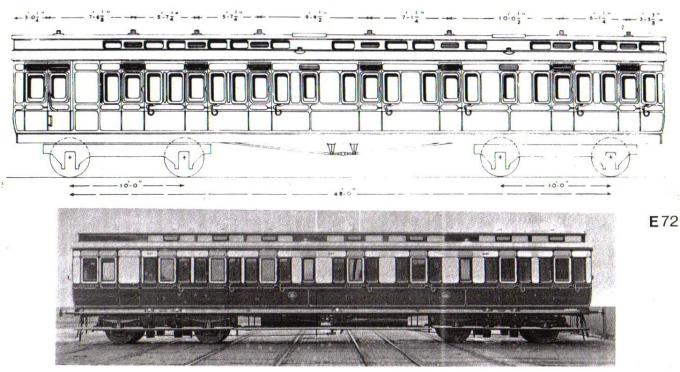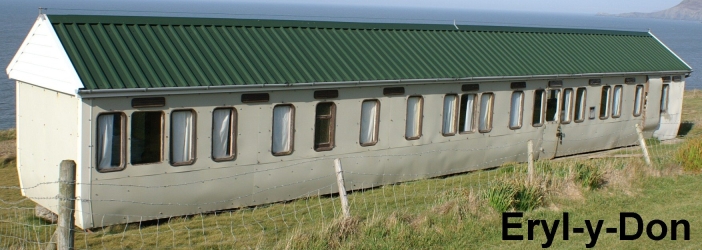History
Eryl-y-Don is a 58-foot, seven-compartment, tri-composite brake coach, one of thirty coaches of this type. It was built on 3rd May 1902. The original number of the railway coach was 1115. Composite coaches had 6000 added to their original number when the Great Western Railway reorganised its passenger coaching stock into a single unified numbering series in 1907. Its current number, visible in the frame of the personnel door into the new extension, is 7115.
The carriage design number is E72, shown in the first figure below where the clerestory roof design is clear. When built, the carriage had
- 2 first-class compartments
- 2 second-class compartments
- 3 third-class compartments
- 4 lavatories
- A combined Guard and Luggage compartment - the brake.
As a result of the abolition of 2nd class on the GWR in 1909, the two second class compartments became thirds.
E72 carriages were built in two batches: 20 to Lot 983 design (nos. 1125-1144) and 10 to Lot 988 (nos. 1115-1124). Eryl-y-Don therefore had Lot 988 layout. Great Western lot numbers were order numbers that were issued by Swindon Drawing Office. The only difference between Lot 983 (shown below in Fig 2) and Lot 988 in the Lot registers is the entry under ‘Notes’: the entry for 983 is ‘Gas, new connections and steam’ whereas that for 988 reads ‘Gas, steam, new connections & electric comms’. The purpose of ‘electric comms’ isn’t stated. If Eryl-y-Don was set up for electric lighting, the gas lighting fitted when the coach ended up at Helyg Fach was a step backwards. Otherwise the lot designs were identical.
As E72 was a ‘non-gangway’ layout, the access to lavatories was arranged so that passengers could not move to sit in better accommodation, as shown in second figure below. The 2nd class passengers had access to one lavatory, but each of the 1st class compartments had its own lavatory; there was no communication between the two compartments. Two of the third class compartments had access to a single lavatory and one third class compartment – the one next to the brake - had no lavatory at all. There were two short corridors connecting the 2nd and 3rd class compartments to their lavatories.
E72 carriages were never converted to have end corridor connections to other coaches. Instead they were demoted to branch line use and new coaches built for through services.
Eryl-y-Don was condemned on 11th January 1931.



The condemned coach found its way via Newcastle Emlyn to a cliff-top field belonging to Helyg Fach Farm, Aberporth. According to John Davies (Aber-porth Chronicle), four railway coaches were taken there when James and Lizzie Lodwick lived in Helyg Fach Farm. He writes:
‘Four railway carriages were hauled into the field above the Tre-saith path, three in the bottom of the field and one in the east top corner, which was a Royal Victorian carriage. [1] They were used as holiday homes. The carriages were brought by railway to Newcastle Emlyn, placed on wheels and pulled to Helyg Fach by steam engine.’
John Davies’s coverage implies this took place when the Lodwicks lived in Helyg Fach, i.e. ‘during the 1930s’ – a date which fits in with the date the carriage was condemned. When I spoke to John in 2019 he recalled seeing the carriages being set up when he was about 10 years old. John was born in 1925. Eryl-y-Don was in the centre of three coaches. The one on the Tresaith side was built in Swindon for Queen Victoria’s Diamond Jubilee celebrations in 1897. It was moved from Helyg Fach in 1982 for display at a Madame Tussaud’s exhibition entitled ‘Royalty and Railways’ at the Windsor and Eton Railway Station. Extensively renovated, it is now on display at the Steam Museum in Swindon. The carriage on the Aberporth side of Eryl-y-Don was destroyed by fire. Eryl-y-Don now stands in splendid isolation.
When Eryl-y-Don’s neighbouring royal coach was removed in 1982, Helyg Fach owner Bryn Williams was reported as saying ‘My father told me that they were towed here by traction engine from Newcastle Emlyn station in 1924’, adding ‘how they ended up in Newcastle Emlyn I don’t know’ (South Wales Evening Post 28th April 1982). He had clearly been told the wrong date. There was a railway station in Newcastle Emlyn until 1973. GWR operated a passenger service there from Carmarthen until 1952. Goods services (including the milk train services to the Co-operative Group creamery) continued to run until 1973. Transporting the coaches to Newcastle Emlyn would therefore present no challenge, but, as Bryn added, ‘it must have been quite a feat for them to bring them down here through the narrow lanes at the time.’ [2]
There are many converted railway carriages close to Eryl-y-Don and it seems likely that they were all moved to Aberporth at around the same time.
- Tony Hughes’s beautifully renovated carriage (Min-y-Mor) on the right-hand side of the cliff path to Aberporth was an eight-wheel family saloon built in 1892. It was used in a Royal train on at least one occasion: at Welshpool, carrying the Prince and Princess of Wales on a three-day tour of Wales in 1896. According to the Railway Heritage Register [3], it was ‘out of service in May 1936’.
- Wendy (on the left hand side of the cliff path to Aberporth) was built in 1905 as a London & South Western Railway sleeping car for the Plymouth-Waterloo boat train. When constructed, it had seven single and two double compartments, a lavatory and an attendant compartment. Taken over by the GWR in 1911, it was converted in 1919 to eight singles and only one double and was condemned in 1931. Wendy is the only known surviving example of its type [4]. According to the website[5] advertising Wendy, ‘in 1936 she was purchased from GWR Swindon and delivered by rail to the (then) Newcastle Emlyn railway station. She was then delivered by lorry and bogey to Aberporth where she has rested ever since.’
- In 1983 Alan and Joyce Bailey of Sutton Coldfield sold their Aberporth holiday-home railway carriage to the Great Western Society at Didcot for restoration[6]. The Tivyside Advertiser (18th March 1983) reported that the coach had been in Aberporth since the early 1920s, ‘having been brought there with others for use as offices by a Captain L. Davies who used to ship slate into Aberporth’. The article continued: ‘It has more of a history than that however having been built as only one of two such sleeping cars for the Great Western Railway in 1874.’
Most railway carriages were taken to Aberporth in the 1930s. The first date on Eryl-y-Don’s land registry is 1933, when presumably the parcel of land on which the coach sits was separated from Helyg Fach. It is possible that Eryl-y-Don was taken to the site that year or shortly after. This fits in with John Davies’s recollections (he was 8 years old in 1933). The Lodwicks would then have changed the internal layout for holiday letting and they may even have let the carriage out themselves. In any event they sold the carriage to its first holiday-making owners in 1936.
The owners of Eryl-y-Don:
- 1933 owners James and Lizzie Lodwick.
- 1936 sold to Evan Owen Evans and Edward Richard Brett Davies.
- 1942 sold to Capt. J.D. Owens.
- 1944 sold to W.G. Thomas.
- 1947 sold to E. Jimmy Davies (Newcastle Emlyn butcher).
- 1964 sold to Anne Demery.
- 1987 sold to Lionel and David Demery and Nigel Crowther
- 2004 transferred to Ruth and Becky Demery.
Notes:
[1] John Davies failed to note that one the other three was also a Royal Victorian coach.
[2] The Tivyside Advertiser was even more confused. It reported that Bryn’s father ‘had purchased [the carriages] from the Great Western Railway in 1924 … His father towed them from Newcastle Emlyn by traction engine.’ We now know that press reports on the date of Victoria’s coach were all mistaken. The carriages were taken to Helyg Fach in the mid 1930s.
[3] http://www.cs.rhrp.org.uk/se/CarriageInfo.asp?Ref=5508
[4] See http://www.cs.rhrp.org.uk/se/CarriageInfo.asp?Ref=5510
[5] https://www.underthethatch.co.uk/wendy
[6] The Great Western Society at Didcot informed me that the coach was beyond restoration and was given to the West Somerset Railway (WSR) who had a similar sleeping car ‘which also came from Aberporth’. I could find no mention of this second sleeper on the WSR website. They broke up the Bailey’s coach for parts.
